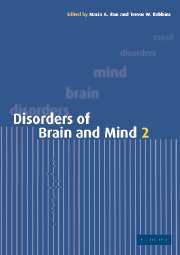Book contents
- Frontmatter
- Contents
- List of contributors
- Preface
- Part I Genes and behaviour
- Part II Brain development
- Part III New ways of imaging the brain
- Part VI Imaging the normal and abnormal mind
- Part V Consciousness and will
- Part IV Recent advances in dementia
- Part VII Affective illness
- Part VIII Aggression
- Part IX Drug use and abuse
- 19 The contribution of genetically manipulated animals to the study of stimulant and alcohol addiction
- 20 The neuropsychology of chronic drug abuse
- Index
- Plate section
- References
20 - The neuropsychology of chronic drug abuse
from Part IX - Drug use and abuse
Published online by Cambridge University Press: 19 January 2010
- Frontmatter
- Contents
- List of contributors
- Preface
- Part I Genes and behaviour
- Part II Brain development
- Part III New ways of imaging the brain
- Part VI Imaging the normal and abnormal mind
- Part V Consciousness and will
- Part IV Recent advances in dementia
- Part VII Affective illness
- Part VIII Aggression
- Part IX Drug use and abuse
- 19 The contribution of genetically manipulated animals to the study of stimulant and alcohol addiction
- 20 The neuropsychology of chronic drug abuse
- Index
- Plate section
- References
Summary
Introduction
There are at least two ways in which cognitive impairments might contribute to drug misuse and drug dependence or addiction. Cognitive impairments, perhaps involving heightened impulsivity, may facilitate drug-seeking behaviour but also undermine the extent to which drug users are able to assimilate and benefit from treatment programmes that often have strong educational and cognitive components (McCrady and Smith 1986; Majewska 1996).
Recent research has seen a rapid expansion of the investigation of neurocognitive deficits in drug abusers and on the relationship between these deficits and neurochemical, morphological and functional pathologies associated with chronic drug use. This research is now able to call upon advances from several areas of cognitive neuroscience, encompassing neuroanatomy and molecular pharmacology (Gurevich and Joyce 1999; Ongur and Price 2000), psychological theory concerning the nature of motivated action and reinforcement mechanisms as they relate to drugs of abuse (see Altman et al. 1996; Everitt et al. 2001 for reviews), and imaging methodologies (Breiter et al. 1997; Volkow et al. 1997; Gollub et al. 1998; Liu et al. 1998) and event-based electroencephalography (McKetin and Solowij 1999) that allow investigation of the physiological correlates of cognitive and emotional activity in the brain. Moreover, the scope of this research is expanding with the preliminary investigation of neurocognitive deficits associated with drugs, such as ketamine, whose potential for abuse is only recently becoming apparent (Curran and Morgan 2001).
- Type
- Chapter
- Information
- Disorders of Brain and Mind , pp. 447 - 467Publisher: Cambridge University PressPrint publication year: 2003
References
- 5
- Cited by



